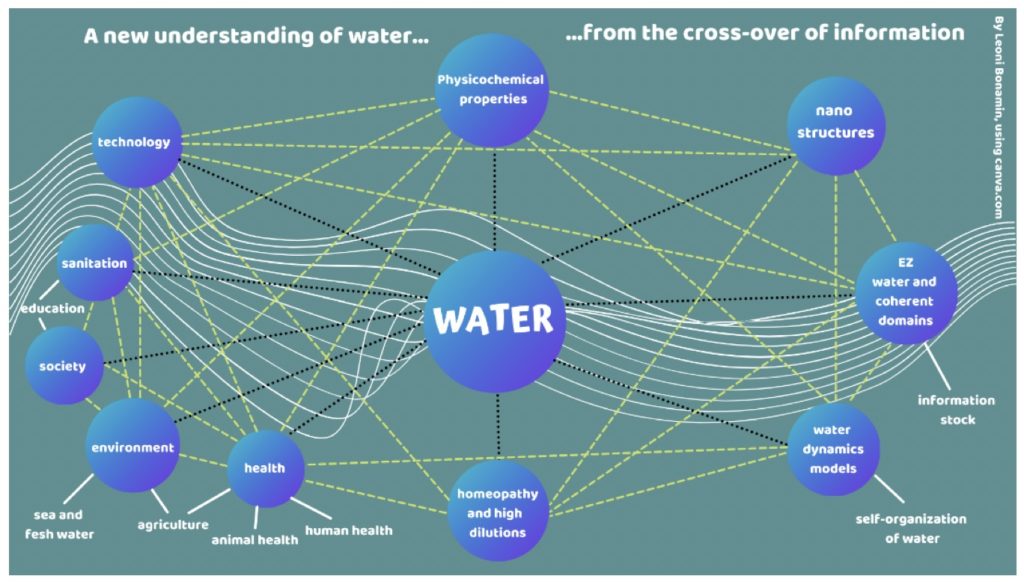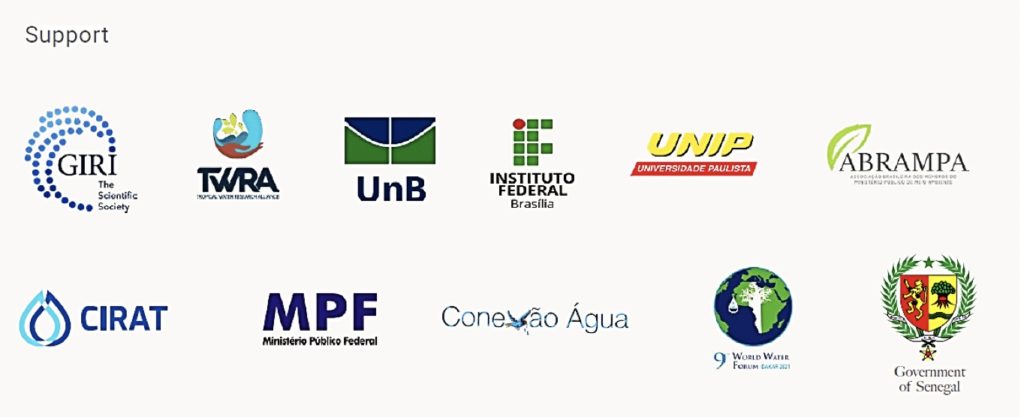SPECIAL EDITION
Editorial
The Transdisciplinarity of Water
Bonamin LV1,2; Ribeiro SA2
1Graduate Program in Environmental and Experimental Pathology –
University Paulista (UNIP). Rua Dr. Bacelar, 1212 – 4th floor.
ZIP-CODE: 04026-002 – São Paulo, São Paulo, Brazil.
2International Centre on Water and Transdisciplinarity (CIRAT) – International Panel on Water Structure (IPWS). Universidade de Brasília, Campus Darcy Ribeiro – Gleba A, 1 andar – Asa Norte, Brasília-DF, Brazil, ZIP-CODE: 70904-970
Author’s e-mails: Leoni V Bonamin (leonibonamin@gmail.com; leoni.bonamin@docente.unip.br); Sergio A. Ribeiro (sergioaugustoribeiro@gmail.com)
Published: April 25, 2022
Dedication
This Special Edition of WATER – A Multidisciplinary Research Journal is dedicated to Dr. Luc Montagnier (1932-2022), Nobel Prize winner in 2008, who dedicated his scientific life to virology and the development of vaccines for AIDS. He inspired scientists worldwide to work in a fair play manner without fear of facing an open discussion on critical subjects even when being misunderstood; to be bold but humble; and to always focus on the benefits for humanity and the planet.
About This Special Edition
In 2019, my colleague Ivana Suffredini and I, a professor at the Graduate Program in Environmental Pathology at University Paulista, São Paulo, Brazil, carried out an exciting task. It was a proposition to master’s and doctoral students to encourage elementary school students to prepare a science fair whose theme was “water.” For four months, the graduate students guided nine- and ten-year-olds to conduct experiments, build models, and create music and dance presentations on the topic, based on each group’s interests and natural aptitudes. The result was surprising, given the realization of the magnitude of children’s awareness of complex issues involving the molecular structure of water in its different states; the importance of basic sanitation and the quality of water for consumption and for the environment; the hegemony of water in the composition of living beings; and the need to build new resources for the sustainable use of water.
Interestingly, in 2020 I received an invitation from Dr. Sergio A. Ribeiro, Director General of CIRAT, to compose the IPWS and organize this special issue for the 9th World Water Forum to be held in Dakar, Senegal, in March 2022, in partnership with the journal WATER — A Multidisciplinary Research Journal, and with the support of Prof. Gerald Pollack, its Editor-in-chief. I gladly accepted the challenge, and for almost two years, we embarked on a multi-step process to offer readers a sample of how frontier science can signal a very different and much more exciting future than we could ever expect. This science is represented in the words sustainable, non-violent, empathetic, and triple healthy, involving humanity, the animal world, and the environment.
Interestingly, when reading the articles sent by the participating authors, I revisited the same themes that had emerged from the children’s creativity a year earlier, as if everything had taken shape: the molecular structure of water, the importance of basic sanitation; new ways to improve the quality of water; and its role in human, animal, and environmental health. I realized that these were not topics for the future. The future is today!
This Special Edition of WATER aimed to disclose advanced knowledge about water at different structural levels, leading to a new understanding of water in response to the challenges of our century. The focus was on the cross-over of information with technical quality and bold thinking, as shown in the diagram.

The objective herein was to gather scientific quality and allow the authors to propose and discuss hypotheses based on the literature defined by the purposes of this project. For this, the manuscripts were initially received after general, but personal invitations were made to more than 200 researchers in the field, whose contributions were evaluated in a pre-selection based on the scope of WATER; they then went through a thorough two-step peer review process.
In the first stage, ad-hoc reviewers were invited to give their opinions. In the second stage, members of the Editorial Board carried out a new detailed analysis of the content to ensure maximum scientific understanding, which is fundamental when it comes to science of the frontier, allowing the authors to be bold in their projects, but at the same time careful with the methodology. Parts of the discussion between authors and reviewers composed the item, “Discussion with the Reviewers (DWR),” at the end of each article, following the authors’ selection criteria. It is an initiative that enriches reflections on the topics addressed and is in harmony with the concept of open science. From the Board’s organization to the design of the editorial flow to peer review, this entire process was carried out voluntarily by all the actors involved.
Then, the articles approved at this stage were reviewed by a professional for final adjustments in English grammar and style. This service was courtesy of IPWS – CIRAT offered to participating authors. WATER professionals carried out the article production stage meticulously, with the third layer of revisions focusing on form and graphic art.
The entire editorial process was philanthropic, there were no costs for the authors, and all WATER articles were published as open access. Authors from five countries participated in this project: Brazil, India, Italy, Russia, and the United States. Given the multidisciplinary nature of this Special Edition, the sequence of articles was organized following a well-defined logic: from the broadest to the most specific topics, culminating in innovative proposals, with the possibility of immediate application. For this, different sessions were organized according to the topics: “Opinion Article,” “Hypotheses,” “Water Structure,” “High Dilutions,” “Water and Environment,” and “New Devices.”
In an opinion article, Palavizini and colleagues surveyed the historical and cultural nature of water that challenges researchers so much, from its role in health and lifestyle to profound questions that emerge from the quest to understand its properties. Physicochemical properties, including the role of water in the imagination of different generations and civilizations, were presented. Finally, the authors trace a faithful portrait of the transdisciplinary profile of water.
Then, two complementary articles deal with the hypotheses about the physical properties of water and high dilutions, associated with the concept of quantum electrodynamics (QED) proposed by Emilio Del Giudice, Giuliano Preparata, and Giuseppe Vitiello in the late 1980s. Manzalini and Galeazzi propose the hypothesis, “The Quantum Nature of Biological Intelligence,” in which adaptive processes typical of living organisms could be defined, in essence, as an expression of biological intelligence, which would operate through “symmetry breaking” phenomena, an extension of the principles of biological intelligence. Nandy and collaborators adopted the concept of QED as an explanatory hypothesis to understand the different properties of water; these range from the most common ones, such as hydration and cleaning, to those lesser known, for example, treatment of diseases and generation of electric energy, whose mechanisms are still not wholly explained by current science.
Still, on evidence of the structure of water, three more articles stand out. In Yahkno and Yakhno, a series of insightful and straightforward experiments were carried out employing optical microscopy, in which diverse sediments formed by the evaporation of saline solutions and suspensions of hydrophilic solid particles reveal the identification of dispersive patterns, which can be defined mathematically. Such patterns suggest two water phases under these conditions: continuous and structured water, which occur near hydrophilic surfaces. Singh et al. follow the same reasoning but with a more refined methodology, using two complementary types of spectroscopies. Thus, very high dilutions of different molecules could be distinguished from each other by the amount of free water in the solution and the strength of the hydrogen bonds present in hydroxyl radicals that are formed during their preparation. In Konovalov et al., nonlinear changes in conductivity, pH, and redox potential were observed at high dilutions, representing dispersed self-organizing systems. In this article, it appears that such processes can be potentiated through the so-called “supramolecular technique method,” developed by Luciano Gastaldi, which opens perspectives for its practical use, especially in agriculture.
Three more articles deepen the discussion of high dilutions. Lobyshev identified non-monotonic impedance patterns in highly diluted diclofenac preparations subjected to vigorous agitation. Such standards are not related to the solute concentration itself but to the sample treatment, being stable for up to 30 days. Zanco made a brief review of basic research at high dilutions and then proposed two non-invasive diagnostic methods (low-power laser and cold plasma imaging), which can be used as tools to assess the germination capacity of seeds, pre-treated with highly diluted substances, a promising resource for high-performance agriculture. Nagai et al. carried out a systematic review of the literature, rescuing studies on the treatment of aquatic organisms with high dilutions of active substances, which are suitable animal models for understanding their mechanisms. Among the studies surveyed, those conducted over 20 years with changes in the rate of metamorphosis in tadpoles stand out. Biological models have been associated with water physicochemical changes after high dilutions exposure. The set of these three articles shows different perspectives on the physical properties of water used in the preparation of high dilutions subjected to vigorous agitation and its impact on biological events. It represents an essential contribution to understanding the mechanisms involved in homeopathic treatment, a topic that is usually controversial in the scientific mainstream but finally finds a way of elucidation.
Finally, Mohammad et al. and Souza et al. show practical aspects of water structuring. In the first case, thirty-six experiments were carried out with Artemia salina and showed that water agitation could facilitate the adaptive processes of brine shrimp embryos to reduce hatching at low concentrations of mercury chloride, and circalunar variations modulated this effect. It suggests an increase in the bioresilience capacity of these organisms to toxic agents. In the second case, the magnetic induction of irrigation water for corn seeds under field conditions modified the germination percentage, although there were no changes in the other parameters studied. It is an inviting study for further research in the area, with the potential for significant impacts on agriculture. The last article of this Special Edition shows a perspective for application in short to medium terms, thus closing the cycle proposed at the beginning of the project: to bridge the gap between basic research on the physicochemical aspects of water structuring and applications with immediate potential. Thus, Jabs and Rubik propose the creation of low-cost/low-tech/low-maintenance design equipment that can be built with relative technical simplicity for the supply of mineralized and structured drinking water in areas of great need. This initiative inspires us to envision the possibility of offering quality water in various regions of the planet with minimal investment, which can reduce social gaps and improve the quality of life fairly and universally.
— Prof. Leoni V Bonamin, DVM, PhD, University Paulista – UNIP, Brazil, Guest Editor of WATER for this Special Edition
About IPWS in the WWF Context
Water plays a vital role in adapting natural and human systems in a climate change scenario, so understanding how this fundamental element of life is organized and functioning is essential. With the aim of gathering, disseminating, and advancing knowledge about water at the micro and nanostructure level, as well as its developments in the different areas of research, the International Panel on Water Structure – IPWS was created during the World Water Forum of Brasília, in 2018. Just as the Toronto Conference in 1986 was a milestone for the climate agenda to spark a process of organization, by the scientific community, of what became the Intergovernmental Panel on Climate Change – IPCC, the 8th World Water Forum held in Brasilia in 2018 became a milestone in the agenda of the micro and nanostructure of water.
The IPWS connects leading researchers who develop research on water structure and related fields of knowledge and their most diverse applications from an interdisciplinary perspective. IPWS gathers and systematizes the knowledge produced by independent high-level scientists, organizations, and governments. It also gives visibility and public understanding of the theme and its numerous practical applications.
The IPWS was launched in 2018 during the Water World Forum in Brasilia; now, in this next edition of the Forum in Dakar, in March 2022, significant advances have taken place. In addition to implementing the Protocol of Intent signed between several institutions and researchers to advance the Panel, 04 IPWS Partner Meetings were held between 2018 and 2021. Research on the use of magnetized water for agriculture within the scope of the project was also stimulated through CITinova, funded by the Global Environmental Facility (GEF), as well as financing a broad survey of research, researchers, and lines of research on the topic of structured water in Brazil and worldwide. Another strategic partnership established was with WATER – A Multidisciplinary Research Journal, directed by Prof. Gerald Pollack of the University of Washington. Dr. Pollack and the Water Journal team have accepted an invitation from IPWS to run a special edition of the journal for the Dakar World Water Forum, which we launched today.
The network of IPWS supporters and researchers gradually expands, as does this critical knowledge about water. In this World Water Forum in Dakar, a new step is taken, with the signing of the Addendum to the Memorandum of Understanding signed in 2018 and new partners’ entry to strengthen the initiative. We are very honored to have partnered with the journal, WATER – A Multidisciplinary Research Journal, and look forward to continuing together in the joint exploration of this fascinating world of water.
— Sergio Augusto Ribeiro, MSc, Director-General, CIRAT- International Centre on Water and Transdisciplinarity, Vice President Water and Heritage ISC – ICOMOS (Latin America and the Caribbean), Executive Secretariat IPWS – International Panel on Water Structure
Credits for the Special Edition for the 9th World Water Forum, Dakar, Senegal
Editor-in-Chief: Prof. Gerald Pollack (University of Washington, Seattle, Washington, USA)
Managing Editor: Laura Colton (WATER)
Guest Editor for this Special Edition: Prof. Leoni V Bonamin (University Paulista, Brazil; CIRAT-IPWS)
Organizational Support: Sergio A Ribeiro (CIRAT – IPWS)
Partnership: CIRAT – International Centre on Water and Transdisciplinarity, Brasilia, Brazil, and IPWS – International Panel on Water Structure
Editorial Board
Concept and Starting Process
- Adriana Ramos de Miranda (Brazil)
- Beverly Rubik (USA)
- Fateme Mirzarjani (Iran)
- Fernando F Putti (Brazil)
- Giuseppe Vitiello (Italy)
- Harry Jabs (USA)
- Igor Jerman (Slovenia)
- Juliano Chaker (Brazil)
- Papiya Nandy (India)
- Paula Petracco (Brazil)
- Redouane Mghaiouini (Morocco)
- Tânia Brito (Brazil)
- Vicente Casali (Brazil)
- Vladmir Voeikov (Russia)
Second Review and Article Approvals
- Adriana Ramos de Miranda (Brazil)
- Beverly Rubik (USA)
- Giuseppe Vitiello (Italy)
- Harry Jabs (USA)
- Igor Jerman (Slovenia)
- Papiya Nandy (India)
- Paula Petracco (Brazil)
- Tânia Brito (Brazil)
- Vladmir Voeikov (Russia)
Additional Acknowledgments
Grace Perpétuo – English grammar and style review
Lauren Russel – Document style review and Copy Editor
Rhonda Dicksion – Graphic Art and IT Director
Volunteer Work and Support
Guilherme Werner – Graphic Design
Thanks to all ad hoc reviewers who collaborated on a volunteer basis for the high quality of this Special Edition.

